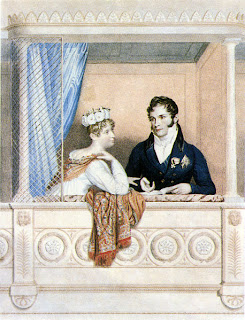Victoria here, back from five wonderful days at the Annual General Meeting of the Jane Austen Society of North America, held this year in Ft. Worth, Texas. Many thanks to all the wonderful volunteers who organized the meeting, led by Dr. Cheryl Kinney and Rosalie Sternberg.
The topic was, of course, Sense & Sensibility, marking the 200th anniversary of Jane Austen’s first published novel. The festivities started on Thursday with a few special presentations, including mine on “The Sensible Regency Wedding.”
Above, I am posing on the stage with Jinger Heath who spoke on “Regency Cosmetics and Esthetics: A Look to Die For” immediately preceding my talk on Thursday night, October 13. Jinger told the audience about some of the dreadful facial concoctions used by regency-era women to whiten their skin, substances containing lead and other poisons. She also told us how some of their formulas — such as rosewater and various oils — were quite beneficial.
Kathy Yank (left, above) introduced me. Using power point, I talked about the usual simplicity and low-key nature of regency weddings, using particularly the examples of Jane Austen’s niece Anna’s wedding to Ben Lefroy in 1814, as described by Anna’s half-sister Caroline Austen, and Annabella Milbanke’s wedding to Lord Byron in 1815, the latter recounted by John Cam Houbhouse (later Lord Broughton).
I also talked about royal weddings (and one non-wedding of the Prince of Wales to Maria Fitzherbert), including the ceremony that united Princess Charlotte of Wales to Prince Leopold of Saxe-Coburg. I covered a number of other topics, like courtship, the weddings in Jane Austen’s family and in her novels, the laws governing marriage, the ceremony itself, and so on. I concluded by speculating on whether Jane Austen yearned for a wedding of her own.
Musing on the remark made by Charlotte Lucas in Pride and Prejudice, “Happiness in marriage is entirely a matter of chance,” I asked: “Was Jane Austen’s happiness a result of chance? Happiness in her literary success was the result of talent, wit, hard labor, and perseverance. Jane Austen’s satisfaction with her accomplishments left nothing to chance.”
On Friday, Dr. Elisabeth Lenckos (above) of Chicago led us in an examination of whether our dispositions are more like Elinor’s or Marianne’s. I seemed to hear about a 50-50 split among those sitting near me.
Dr. Joan Ray presented the North American Scholar Lecture at the opening plenary session. She analyzed “Sense & Sensibility as Austen’s Problem Novel,” citing various difficulties readers, particularly her students, have with the characters and plot. Perhaps most obvious among these problems is whether or not Marianne will find happiness as the wife of Col. Brandon. Dr. Ray, in her charming and humorous manner, convinced us by reading from the text some perhaps-overlooked aspects of Marianne’s and the Colonel’s behavior and opinions that emphasized the empathetic nature of their personalities. Their essential compatibility, she assured us, would bring them happiness.
As always at JASNA AGMs, it is difficult to chose among the wonderful break-out sessions offered by dozens of well-spoken presenters with a variety of intriguing topics.
My good friend Elizabeth Philosophos Cooper of Madison talked about “Jane Austen, Publisher: Writing Herself Into Money and Longing for More.” Liz documented the publication process for each of Austen’s novels, from early unsuccessful attempts through her various methods of reaching publication to the actual funds she received for some of her work, some during her lifetime, and more after her death.
Jeffrey Nigro, Chicago Regional Coordinator, spoke on “The Iconography of Sensibility,” illustrating how artists and poets extoll
ed the beauty and drama of the emotional expressionism of the era.
William Phillips, also of Chicago, counted down from the least egregious of the nasties to the worst of the examples in Sense & Sensibility in his talk “Meaner than a Texas Pole-cat: Present day Perspectives on Austen’s Largest Cast of Nasties.” It wasn’t easy to chose the worst among some of the revolting people in S&S, like John and Fanny Dashwood, Mrs. Ferrars and her son Robert — but of course the nastiest of all was the vindictive and sly Lucy Steele.
I will report further on the activities at Fort Worth — from an exciting book launch, to the brilliant ball, to the outstanding talks by Andrew Davies and Deirdre Le Faye — in my next posts.
Stay tuned for much, much more.




Wow! What a fabulous line up of presentations! You need to do your Regency Weddings presentation for the Beau Monde Conference!
All of these lectures sound fascinating.
I heard from my fellow Risky Regencies, Amanda McCabe/Laurel McKee and Janet Mullany, that your talk was terrific, Vicky.
I'd love to attend next year.